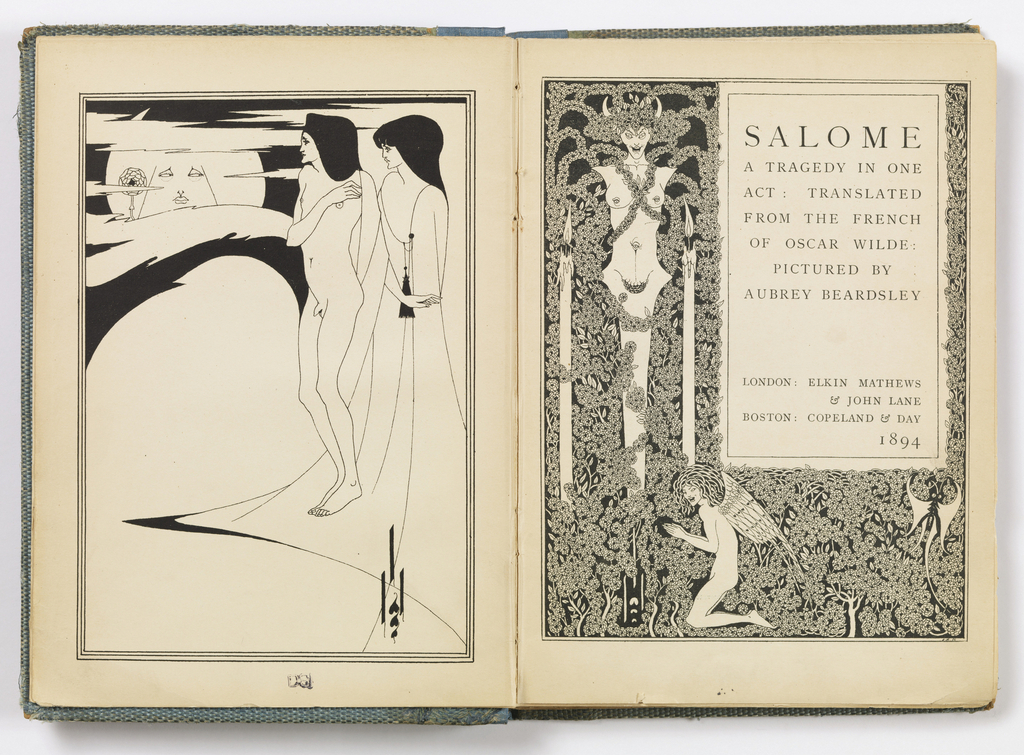Design intersects in countless ways with other creative disciplines. Some intersections that are particularly symbiotic are book and graphic design with writing and literature. Form follows function, content dictates form—the written word drives the design. In the below list, works of autobiography, theater, fiction, cultural criticism, and more inspire iconoclastic illustration, bold works of graphic modernism, and postmodern delights. Despite the title “The Library Is Open”—lovingly borrowed from the grand tradition of Paris Is Burning—this list (drawn from Cooper Hewitt’s collection and publishing program) does not intend to throw shade, but rather celebrate LGBTQIA+ authors and the designers who visualized and produced their work.
Gertrude Stein
Designed by ALVIN LUSTIG

Book Cover, Bookjacket for Three Lives, 1947
Written by Gertrude Stein (American 1874–1946)
Designed by Alvin Lustig (American, 1915–1955)
Published by New Directions Books (New York, New York, USA)
Lithograph in blue, green and black ink on white shiny wove paper
18.5 × 16.2 cm (7 5/16 × 6 3/8 in.)
Gift of Tamar Cohen and Dave Slatoff, 1993-31-165-1
Three Lives contains three novellas, each centered on the life of a woman. It was Gertrude Stein’s first published book, and, while Stein worked to get it published, her partner Alice Toklas prepared book proofs. Stein funded the first printing herself in 1909 and it became one of her most read books, meriting this later edition published by New Directions Books. Lustig’s striking book cover depicts three female bodies floating serenely in a field of color, unifying the three separate stories.
Audre Lorde
designed by SHIRLEY WOODSON

Chapbook, The New York Head Shop and Museum, 1974
Written by Audre Lorde (American, 1934–1992)
Designed by Shirley Woodson (American, born 1936)
Published by Broadside Press (Detroit, Michigan, USA)
Offset lithograph on paper
21.5 × 13.7 × 0.5 cm (8 7/16 × 5 3/8 × 3/16 in.)
Gift of Ellen Lupton, 2021-34-6
“Broadside Press published books featuring new work by emerging and established poets. Stapled together at the center, books in this format are called chapbooks or pamphlets. Chapbooks have a long tradition in independent publishing, from fine press editions to photocopied zines . . . Many Broadside Press covers feature photographs, drawings, or hand lettering. Shirley Woodson created beautiful lettering and cover typography for The New York Headshop and Museum, a book by Audre Lorde that marked the growing role of feminists in the Black literary scene. . . .” — Ellen Lupton
For more on Broadside Press, see Ellen Lupton, “Broadside Press and Black Graphic Design.”
Christopher Isherwood
illustrations by E. McKNIGHT KAUFFER
Print, Cover Design for Lions and Shadows, 1938
Written by Christopher Isherwood (British-American, 1904–1986)
Designed by E. McKnight Kauffer (American, 1890–1954)
Published by Hogarth Press (London, England)
Lithograph on paper
22.6 × 14 cm (8 7/8 × 5 1/2 in.)
Gift of Mrs. E. McKnight Kauffer, 1963-39-423
Lions and Shadows, published by the Hogarth Press in 1938, was the first of Christoper Isherwood’s many autobiographical writings, many detailing his life as a gay man. This title covers his time in Cambridge, England, while he worked a variety of jobs while matriculating in the UK’s literary circles of the 1930s. In addition to numerous other works, Isherwood wrote Goodbye to Berlin, which was the inspiration for the musical Cabaret.
The illustrations for Lions and Shadows were created by American artist E. McKnight Kauffer, who had established his career in England and was part of a modern, queer milieu of a variety of cultural figures.
Susan Sontag
designed by CARIN GOLDBERG

Book Cover, Against Interpretation, 1990
Written by Susan Sontag (American, 1993–2003)
Designed by Carin Goldberg (American, 1953–2023)
Featuring artwork by Jasper Johns (American, born 1930)
Published by Anchor Books (New York, New York, USA)
Lithograph on paper
20.5 × 28.3 cm (8 1/16 × 11 1/8 in.)
Gift of Steven Heller, 1996-74-111
“Does the author of ‘Notes on ‘Camp’’ have to come out?” So asks critic Wayne Koestenbaum in the documentary Regarding Susan Sontag regarding author Susan Sontag. While Sontag had relationships with women and men, some in the queer community felt frustration that she little acknowledged her sexuality. Against Interpretation, a collection of Sontag essays originally published in 1966, contains the essential queer text “Notes on ‘Camp,’” an attempt to articulate the subversive, elusive aesthetic of Camp. Carin Goldberg designed the covers for a series of republished Sontag writings in the 1990s, including this title.
Oscar Wilde
illustrations by AUBREY BEARDSLEY

Frontispiece and Title Page, Salome, 1894
Written by Oscar Wilde (Irish, 1854–1900)
Illustrated by Aubrey Vincent Beardsley (English, 1872–1898)
Lithography on paper
22 × 30.5 cm (8 11/16 in. × 12 in.)
Smithsonian Institution Libraries, PR5820 .S2 E1894
While Oscar Wilde looms large in queer history, his writing was often eclipsed by his persona and, in the case of his play Salome, overshadowed by the accompanying illustrations by Aubrey Beardsley. Beardsley devised otherworldly, fantastical imagery to vaguely support Wilde’s text, imagery that nonetheless flouted rigid Victorian moral norms to center queer and proto-feminist values. Wilde may be an iconic gay, but Beardsley’s singular artistic style transcends his short life.
For more on Beardsley’s illustrations for Wilde’s tragedy, see Matthew Kennedy, “There’s Something About Salome.”
Willi Smith
designed by POLYMODE
Book Cover, Willi Smith: Street Couture, 2020
Edited by Alexandra Cunningham Cameron
Designed by Polymode
Published by Cooper Hewitt, Smithsonian Design Museum with Rizzoli Elekta
Fashion designer Willi Smith worked across creative disciplines to collaborate and expand his design creativity and brand reach. In 2020, Cooper Hewitt organized the first exhibition focused on Smith’s work in Willi Smith: Street Couture. The exhibition and accompanying book were designed by Polymode, a bi-coastal, queer, and minority-owned design studio lead by Brian Johnson and Silas Munro.
For more on the work of Willi Smith, see the digital exhibition platform Willi Smith: Street Couture.
Tennessee Williams
designed by ALVIN LUSTIG

Book Cover, A Streetcar Named Desire by Tennessee Williams, 1947; Designed by Alvin Lustig (American, 1915–1955) for New Directions Books (New York, New York, USA); Lithograph on paper; H × W: 23.5 × 17.1 cm (9 1/4 × 6 3/4 in.); Gift of Susan Lustig Peck, 2001-29-28
Book Cover, A Streetcar Named Desire, 1947
Written by Tennessee Williams (American, 1911–1983)
Designed by Alvin Lustig (American, 1915–1955)
Published by New Directions Books (New York, New York, USA)
Lithograph on paper
23.5 × 17.1 cm (9 1/4 × 6 3/4 in.)
Gift of Susan Lustig Peck, 2001-29-28
Tennessee Williams’s work often includes a phantom queer character—Blanche’s husband in A Streetcar Name Desire who she disparagingly refers to as “the boy”; Brick’s “friend” in Cat on a Hot Tin Roof; cousin Sebastian in Suddenly Last Summer—typically a gay male character who died tragically before the plot starts but who haunts the proceedings of the non-queer characters trying to blamelessly move on. Alvin Lustig’s designs for Williams’s work, and Elaine Lustig Cohen’s work after Alvin’s death, often capture such a chilling vacancy. With Streetcar, the central trio appears expressionless while they intertwine menacingly in a void.
For more on book covers for Williams’s work, see Ellen Lupton, “Tennessee Williams and the Art of the Book Cover,” and for more on the cover design for A Streetcar Named Desire, specifically, see Matthew Kennedy, “A Teetering Trio in a Pastel Void.”
Anne Fausto-Sterling
designed by LOUISE FILI

Book Cover, Myths of Gender, 1992
Written by Anne Fausto-Sterling (American, born 1944)
Designed by Louise Fili (American, born 1951)
Published by Basic Books (New York, New York, USA)
Ink on paper
23.4 × 33.4 cm (9 3/16 × 13 1/8 in.)
Gift of Steven Heller, 1996-74-84
Sexologist Anne Fausto-Sterling offers biological evidence against societally constructed differences between women and men. For the cover, Louise Fili plays on the traditional gender binary by including figures of a classic-looking girl and boy divided by rigid typography on a clinical white background.
Fausto-Sterling is married to Pulitzer Prize–winning playwright Paula Vogel.
Matthew Kennedy is the Publications Associate at Cooper Hewitt and History & Collections Chair of Smithsonian Pride Alliance.




















